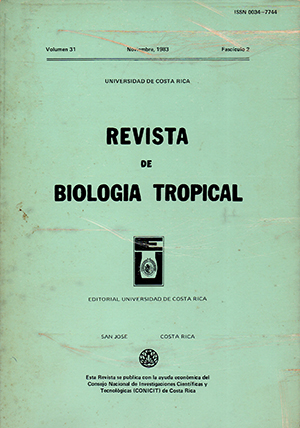Resumen
Fue llevado a cabo un análisis de 23 características dermatoglíficas palmares y digitales en tres poblaciones de Amerindios Guaymí, Abrojo y Limoncito del suroeste de Costa Rica. Además, se estudiaron los dermatoglifos en función del sexo, la bilateralidad o asimetría y las diferencias de patrones entre subgrupos. La muestra poblacional en estudio incluyó a 134 hombres y 127 mujeres agrupadas según su origen étnico y lingüístico en Guaymí oeste (Movere) de Limoncito y Abrojo y Guaymí este (Murire o Buglere) de Limoncito. En relación a otros grupos amerindios los Guaymies presentaron un recuento promedia por dígito y un recuento total de líneas muy bajo. Dentro del grupo Guaymí el subgrupo Movere muestra semejanzas en los diferentes patrones en ambas localidades. Sin embargo, existen diferencias significativas entre los Murire y los Movere en relación al recuento total de líneas ab, bc) el ángulo atd, la frecuencia de dibujos en la zona interdigital 4, la bilateralidad, y el sexo. Estos resultados confirman la existencia de una divergencia evolutiva marcada entre estos dos grupos (Murire y Movere). Son discutidas algunas implicaciones taxonómicas y evolutivas de estos resultados y se hacen algunas consideraciones teóricas sobre la medida de bilateralidad y el sexo.Citas
Alter, M. 1965. Is hiperploidy of sex chromosomes associated with reduced total finger ridge count? Am. J. Hum. Genet. 17: 473-475.
Barrantes, R. y Azofeifa, J. 1981. Demografía genética de los Amerindios Guaymí de Limoncito, Costa Rica, Rev. Biol. Trop., 29: 123-131.
Barrantes, R., P.E. Smouse, J.V. Neel, H.W. Mohsenwaiser and H. Gershowitz. 1982. Am. J. Phys. Anthrop. 58: 201-214.
Cooke, R. 1982. Los guaymí sí tienen historia. Centro de Estudios y Acción Social. Panamá (CEASPA), Panamá. p. 27-64.
Coope, E., D.F. Roberts. 1971. Dermatogliphic of populations in Latin America, p. 405-453. In F.M. Salzano, (ed.). The ongoing evolution in Latin American populations. Charles C. Thomas, Chicago.
Cummins, H. y C. Midlo. 1961. Finger prints palms and soles: an introduction to dermatoglyphics. Dover press, New York, 319 p.
Fitch, W.M. y J.V. Neel. 1969. The phylogenetic relationship of some Indian tribes of Central and South America. Amer. J. Hum. Genet., 21: 284-297.
Forbes, A.P. 1964. Fingerprints and palm prints (dermatoglyphics) and palmar flexion creases in gonadal dysgenesis, pseudohypoparathyroidism and Klinefelter's syndrome. N. Engl. J. Med., 270: 1268-1277.
Hoff, C., C.C. Plato, R.M. Garruto, & J. Dutt. 1981. Dermatoglyphic assesment of the genetic relationships of native American Populations. Am. J. Phys. Anthrop. 55: 455-461.
Holt, S.B. & J. Lindsten. 1964. Dermatoglyphic anomalies in Turner' syndrome. Ann. Hum. Genet., 28: 87-100.
Johnson, F. 1 948. The Caribbean Lowland tribes. The Talamancan division, p. 231-251. In J.H. Steward (ed.): Handbook of South American Indians, Vol. 4. Washington, D.C. U.S. Goverment Printing Office.
Linares, O. & A. Ranere. 1980. Adaptative radiation in Prehistoric Panama. Peabody Museum Press, Harvard, 530 p.
Rothhammer, F., J.V, Neel, F. Da Rocha & G. Y. Sundling. 1973. The genetic structure of a tribal population, the Yanomama indians. VIII. Dermatoglyphic differences among villages. Amer. J. Hum. Genet., 25: 152-166.
Rothhammer, R., R. Chakraborty, & E. Llop. 1977. A collation of marker gene and dermatoglyphic diversity at various levels of population differentiation. Am. J. Phys. Anthropol. 46: 51-60.
Spielman, R.S., E.C. Migliazza, J.V. Neel, H. Gershowitz & R. Torres. 1979. The evolutionay relationships of two populations: A study of the Guaymi and the Yanomama. Current Anthrop. 20: 377-388.
Torres de Arauz, R. 1980. Panamá indígena. Instituto de Cultura, Panamá. p. 215-270.
Young, P.D. 1971. Ngawbere: Tradition and change among the western Guaymi of Panamá. Urbana: University of Illinois Press, 257 pp.
Young, P.D. & J.R. Bort. 1979. The politicization of the Guaymi. J. Steward, Anthrop. Soc. 11: 73-110.
Comentarios

Esta obra está bajo una licencia internacional Creative Commons Atribución 4.0.
Derechos de autor 1983 Revista de Biología Tropical






